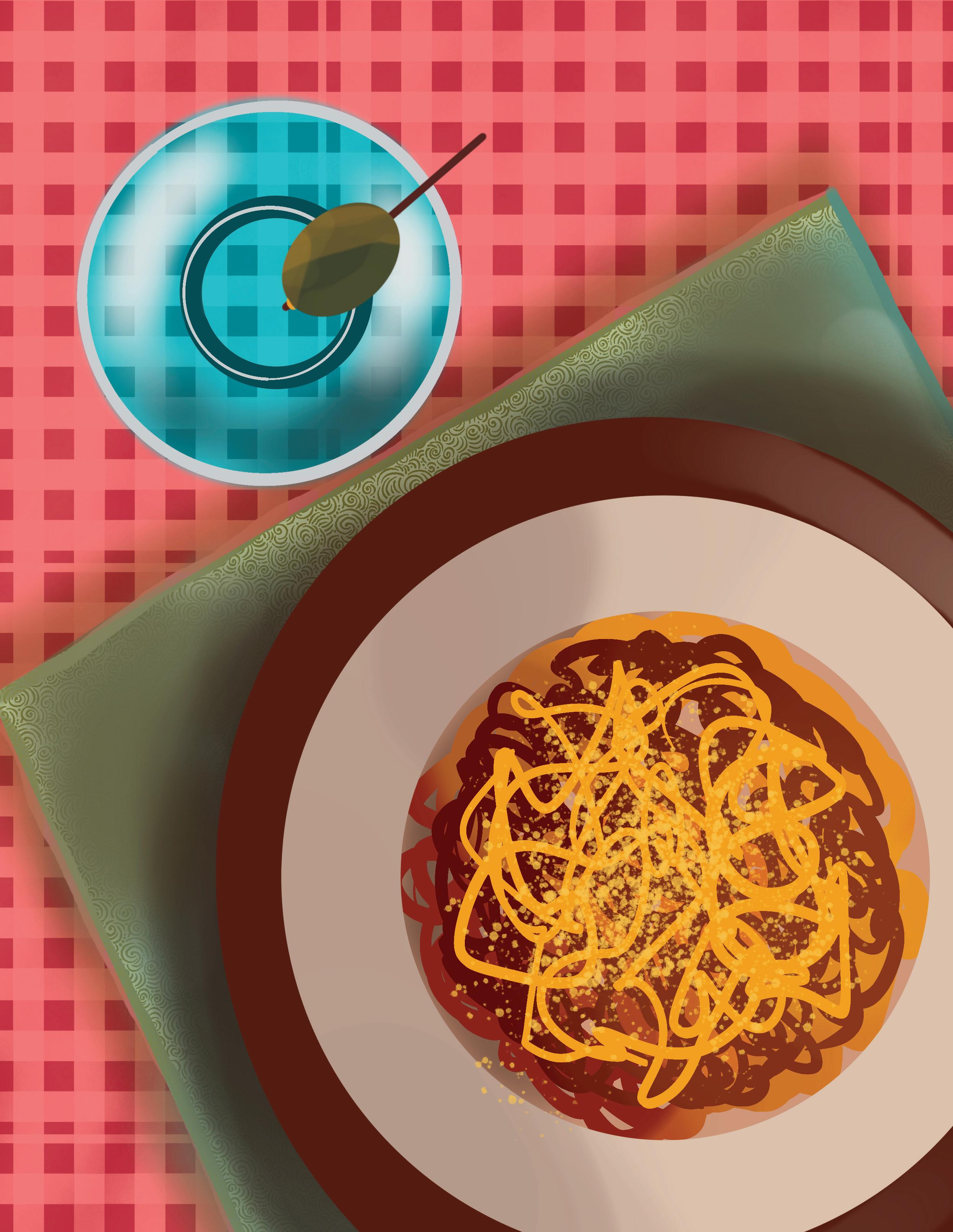
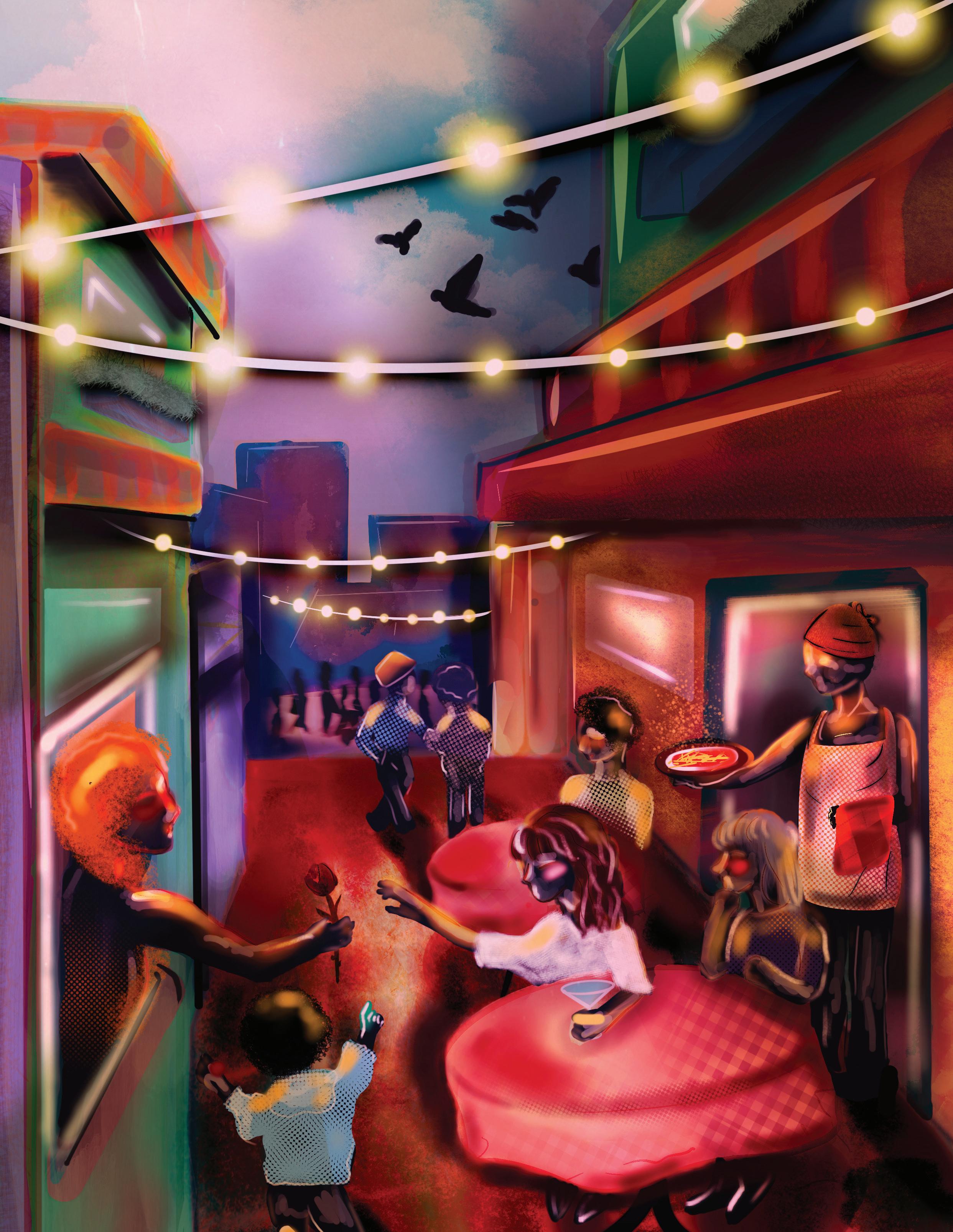
HUNDREDS PROTEST AS JEWISH LIFE AND ISRAEL ALLIANCE HOST PANEL WITH IDF SOLDIERS
By Eddy Binford-Ross, Franziska Wild, and
Sydney Carroll
DAI TRE FRATELLI: COMFORT COOKED AL DENTE
By Sofia Kemeny and Kristy Li
JACOB MURRELL IS REACHING NEW HEIGHTS WHILE STAYING LOCAL
By Andrew Swank
MARCH 1, 2024
10 news
Old legacies, new approaches: Reworked diversity requirement to take effect next year
CAROLINA BOMENY
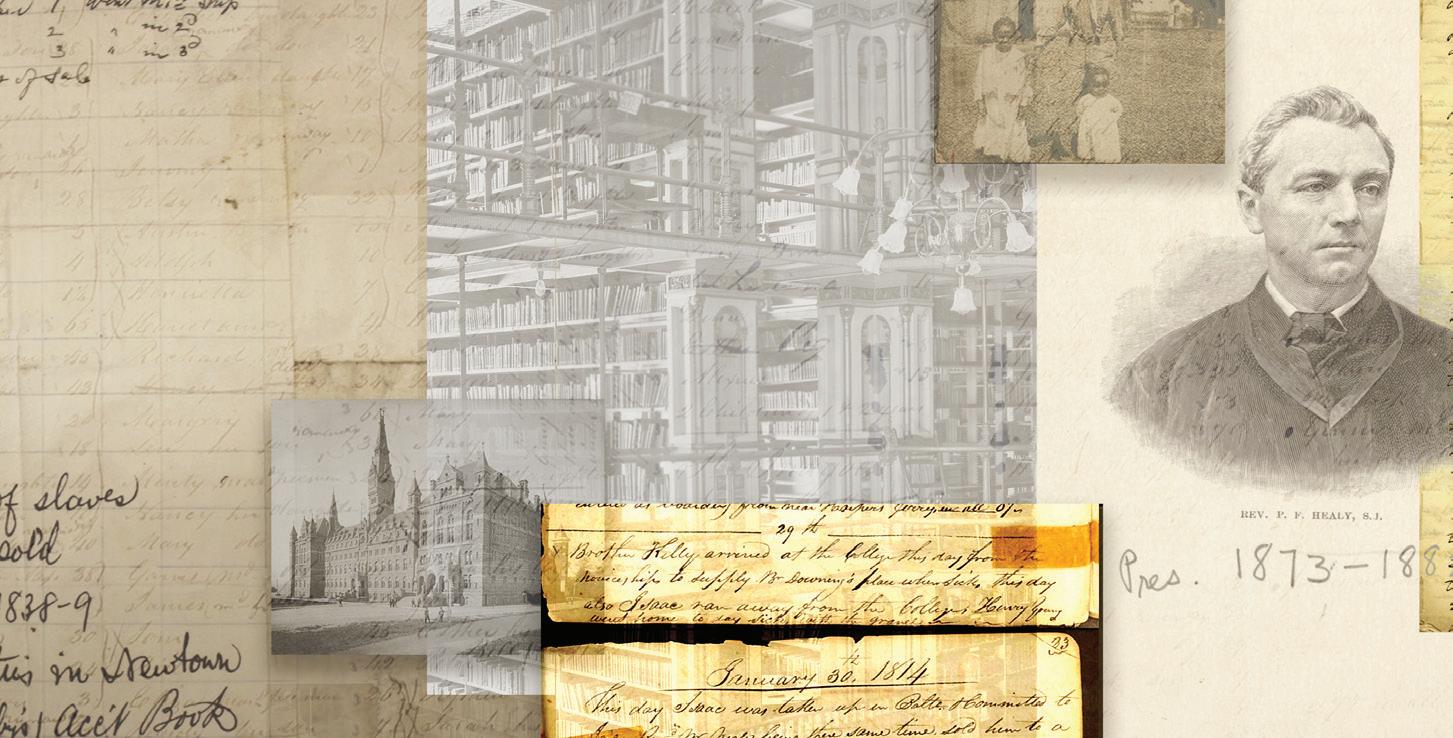
4 news
Hundreds protest as Jewish Life and Israel Alliance host panel with IDF soldiers
8 news
On 16th and U streets, neighbors push for equity in rezoning
SAM MONTEIRO AND FRANZISKA WILD
6 voices Put a bow on it: A blissful reclamation of .“coquette”
ALEXANDRA LALLI
7 voices
Say more with less
ALEXIS TAMM
11 editorials
Ensure Georgetown workers get what they deserve
EDITORIAL BOARD
on the cover
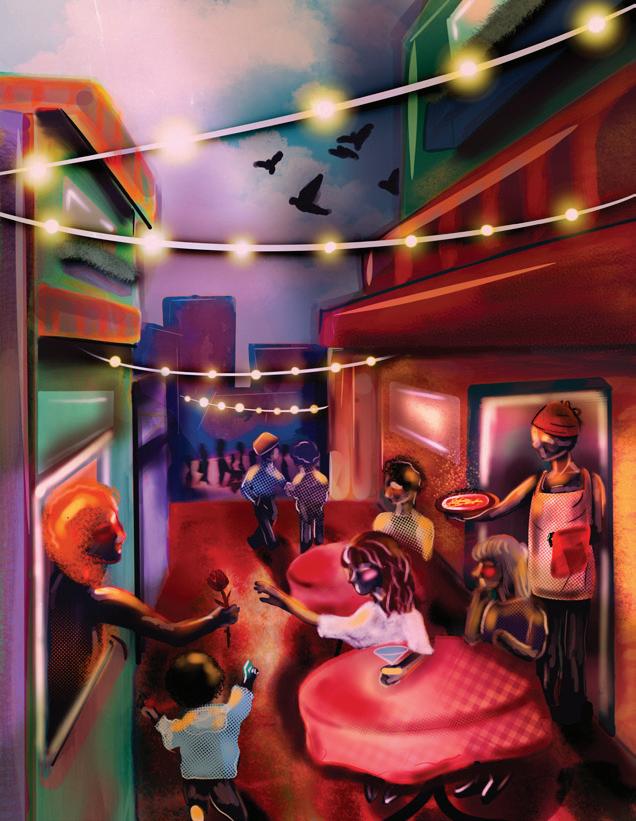
12 halftime leisure From house to hoedown: Beyoncé takes on country in surprise new singles
AJANI JONES AND IMANI LIBURD
13 sports Jacob Murrell is reaching new heights while staying local ANDREW SWANK
14 leisure
Dai Tre Fratelli: Comfort cooked al dente
SOFIA KEMENY AND KRISTY LI
Editor-In-Chief Graham Krewinghaus
Managing Editor Ajani Jones
internal resources
Executive Editor for Resources, Diversity, and Inclusion Lukas Soloman
Assistant Editor for Resources, Diversity, and Inclusion
Editor for Sexual Violence
Advocacy and Coverage
Aminah Malik
Alison Karki
Service Chair Margaret Hartigan
Social Chair Bradshaw Cate, Jo Stephens
Archivist Megan O'Malley
news
Executive Editor Amber Xie
Features Editor Eddy Binford-Ross
News Editor Franziska Wild
Assistant News Editors Katie Doran, Sydney Carroll, Aashna Nadarajah
opinion
Executive Editor Barrett Ahn
Voices Editor Olivia Pozen
Assistant Voices Editors Eileen Miller, Alison Karki, Ali Chaudhry
Editorial Board Chair Sabrina Shaffer
Editorial Board Connor Martin, Brandon Wu, Nora Scully, Jupiter Huang, Lou Jacquin, Olivia Pozen, Lukas Soloman, Dane Tedder, Andrea Ho leisure
Executive Editor Zach Warren
Leisure Editor Hailey Wharram
Assistant Editors Nikki Farnham, Sofia Kemeny, Rhea Banerjee
Halftime Editor Eileen Chen
Assistant Halftime Editors Gabriel Mendoza, Sagun Shrestha, Francesca Theofilou
sports
Executive Editor Jo Stephens
Sports Editor Henry Skarecky
Assistant Editors Ben Jakabcsin, Andrew Swank, Langston Lee
Halftime Editor Bradshaw Cate
Assistant Halftime Editors Sam Lynch, Anna Cordova, Andrew Arnold design
Executive Editor Grace Nuri
Design Editor Tina Solki
Spread Editors Olivia Li, Pia Cruz
Cover Editor Bahar Hassantash
Assistant Design Editors Rachel Zhang, Madeline Jones, Elin Choe
copy
Copy Chief Cole Kindiger
Assistant Copy Editors Rania Khan, Maanasi Chintamani, Isabel Shepherd
multimedia
Multimedia Executive Connor Martin
Podcast Executive Producer Romy Abu-Fadel
Podcast Editor Lucy Collins
Photo Editor Izzy Wagener
online
Online Executive Tyler Salensky
Website Editor Mj Morales
Social Media Editor Kristy Li
Assistant Social Media Editor Mark Manaois
business
General Manager Rovi Yu
Assistant Manager of Accounts and Sales Mini Xue
"If Georgetown wants to embody the Catholic value of dignified work, it should not continue to partner with a
company that participates in labor exploitation,
upholds
the prison-industrial complex, and profits off of workers’ rights violations.
PG 11
The
"
Assistant Manager of Alumni and Outreach Ninabella Arlis
support
Contributing Editors Adora Adeyemi, Angelena Bougiamas, Lou Jacquin, Lucie Peyrebrune, Nora Scully
Associate Editor
Staff Contributors Jack Kealey Meriam Ahmad, Carolina Bomeny, Mia Boykin, Elyza Bruce, Elspeth Campbell, Romita Chattaraj, Leon Cheung, Yihan Deng, Ryan Goodwin, Paul Kang, Julia Kelly, Ashley Kulberg, Imani Liburd, Nicholas Romero, Carlos Rueda, Isabella Stratta, Kami Steffenauer, Amelia Wanamaker, Nadine Zakheim
2 THE GEORGETOWN VOICE Contents contact us editor@georgetownvoice.com Leavey 424 Box 571066 Georgetown University 3700 O St. NW Washington, DC 20057
opinions expressed in The Georgetown Voice do not necessarily represent the views of the administration, faculty, or students of Georgetown University, unless specifically stated. Columns, advertisements, cartoons, and opinion pieces do not necessarily reflect the views of the Editorial Board or the General Board of The Georgetown Voice. The university subscribes to the principle of responsible freedom of expression of its student editors. All materials copyright The Georgetown Voice, unless otherwise indicated. March 1, 2024 Volume 56 | Issue 11
EDDY BINFORD - ROSS, FRANZISKA WILD, AND SYDNEY CARROLL
“Espresso Martini”
BAHAR HASSANTASH
graphic by sabrina shaffer; layout by tina solki
Page 3
→ GRAHAM'S CROSSWORD
An eclectic collection of jokes, puns, doodles, playlists, and news clips from the collective mind of the Voice sta

DOWN:
1. Ball, mystically
2. Christ the Redeemer locale and animated film about birds
3. Computer component, for short
4. The Capitol Bldg. has 100 of these
5. Recent Epi noodle bar addition
6. Debt reminder abbreviation
7. Thousands of lbs.
8. 4-Down's in favor might say this
10. Degree your young professor might still be working toward
12. Iowa output
13. Swanky
15. Superlative suffix
16. Speed measurement
17. Anger; indignation
18. ___ and tonic
19. “To ___ is human; to forgive, divine”
20. Back to the Future (1985)
actress Thompson
21. H.S. exam for which to brush up on vocabulary
22. ___ out; barely manage
→ TUNE IN TO PODCASTS
On this episode of Post Pitch, listen to Voices's Alexandra Lalli discuss the origin and reclamation of "coquette" with Podcast Executive Producer Romy Abu-Fadel, using the QR code:


ACROSS:
1. Tolkien monsters
5. Olive Branch bread, often
9. Ready to harvest
10. Fraudulent, informally
11. Pogo-ist's place of residence, perhaps
14. Washed up
15. One seeking asylum
19. Alternatively
23. Pogo sticks problem, perhaps
25. Consequently
26. Make bubbly
27. Cable channel with Chuck and Shaq
28. Pogo-ing pioneer, perhaps
36. Seize by force, as a throne
37. With “the”, Georgetown's newspaper of record from 1920 until 1969
24. Second stage of testing, for software
27. Baking measurement
28. Au ___ (French sandwich style)
29. “Party in the ___”
30. Corp's Midnight ___
31. Post- opposite
32. Greek letter after pi
33. Pinnacle
34. I Spy instrument
35. Totally tubular


→ CHECK OUT OUR NEWSLETTER!
The Voice is coming to your inbox!
Subscribe to our new weekly newsletter at mail.georgetownvoice.com.
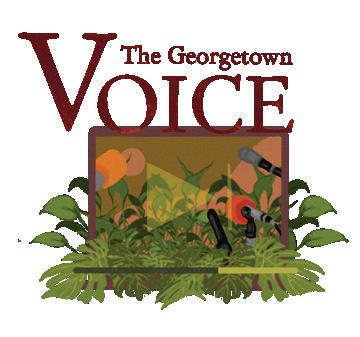
→ PIA'S RATTY SAMSTACK

→ THE VOICE'S LEAP YEAR MIX
The Voice staff's time capsule for the next four years. We'll see you in 2028!
2024: “Saturn” by SZA
2020: “Do It” by Chloe x Halle
2016: “One Dance” by Drake
2012: “Lost" by Frank Ocean
2008: “Single Ladies (Put A Ring On It)” by Beyoncé
2004: “Mr. Brightside” by The Killers
2000: “Oops!...I Did It Again” by Britney Spears
3 MARCH 1, 2024
crossword by graham krewinghaus; newsletter graphic by
han ;
" by
;
deborah
" ratty samstack
pia cruz
podcast graphic by pia cruz
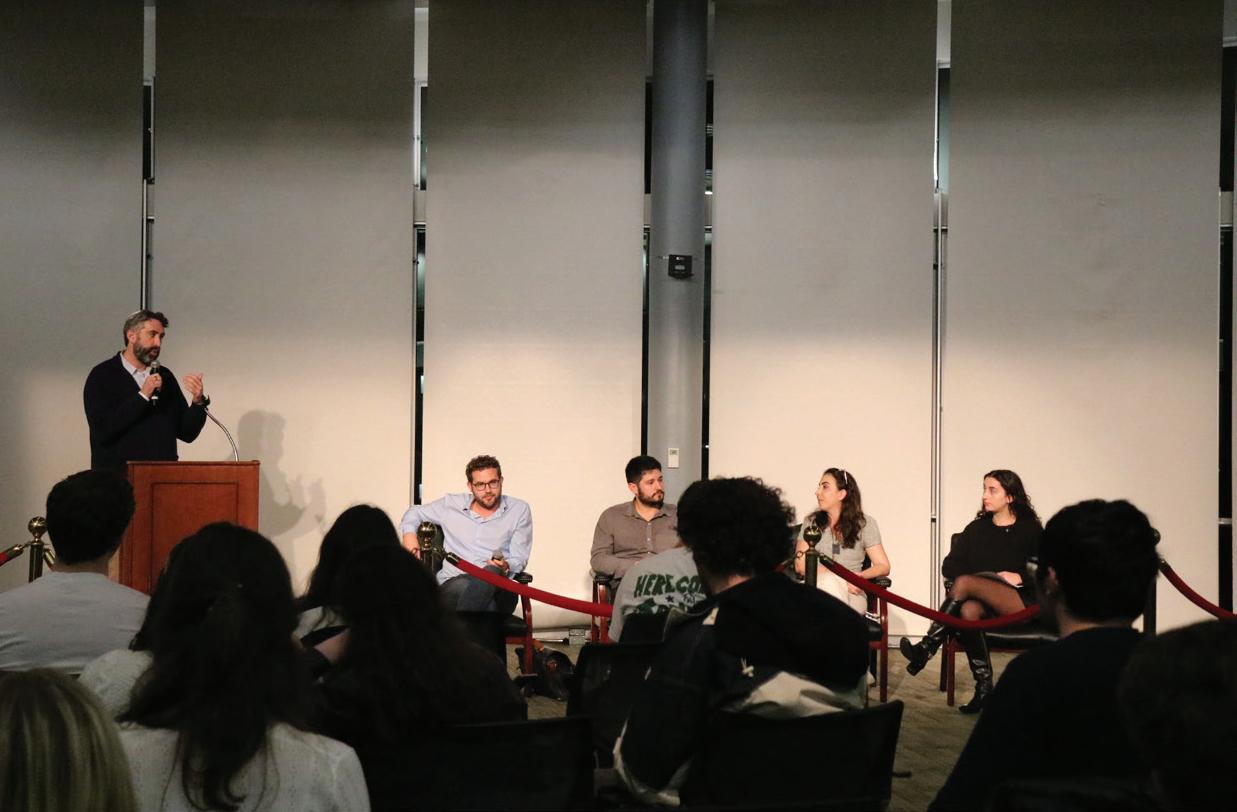
Content warning: This article contains mention of anti-Palestinian racism, antisemitism, genocide, selfimmolation, and lynching.
Over 250 protesters gathered on Feb. 27 as Jewish Life, a branch of Campus Ministry, and the Georgetown Israel Alliance (GIA) hosted a panel with members of the Israel Defense Forces (IDF). The protests were sparked by the decision to bring IDF soldiers to campus amid Israel’s ongoing occupation and war in Gaza, which experts, including top UN officials, have called a genocide.
On Oct. 7, Hamas militants attacked Israel, killing 1,200 Israelis and taking at least 250 hostages. Following the attack, Israel invaded Gaza and began a series of airstrikes which have killed 30,000 Palestinians and displaced 1.7 million more.
The Feb. 27 protests began in Red Square at 6 p.m. and were organized by members of Students for Justice in Palestine (SJP), Jewish Voice for Peace (JVP), Faculty and Staff for Justice in Palestine (FSJP), and Zeytoun, a graduate student organization that advocates for decolonization in southwest Asia and North Africa. The protesters marched to the Rafik B. Hariri Building at approximately 7 p.m. to chant outside the event while others protested inside.
The panel, which began at 7 p.m. in Hariri, featured three current or former IDF soldiers: Noam Kara (who works at Campus Ministry as the Jewish Agency Israel Fellow), Benaya Cherlow, and Avi Eisen.
Rabbi Daniel Schaefer, the interim director for Jewish Life, opened the panel by addressing the approximately 60 attendees, saying that the event provided a space for Jewish students to hear Israeli perspectives on campus, something he feels is lacking.
“Our goal for the event was to create a small, intimate space for the Jewish community to hear from Israelis who have been serving in the military, both before and after Oct. 7; to learn about their experiences and what it means to be an Israeli in this moment; to ask difficult questions and to understand more deeply their relationship to Israel and the war and to have a safe space for that conversation,” Schaefer said in an interview with the Voice
Within Georgetown’s Jewish community, reception to the panel was mixed. For some, the event provided the opportunity to feel a sense of unity and connection to each other.
Nicole Horne (MPP ’25) approached Jewish Life with the idea for the panel a couple of weeks ago.
She recalled several attendees coming up to her after the event with tears in their eyes to tell her how much the event meant to them.
“They were crying and were like, ‘Thank you so much for doing this, it’s been really hard and this is so nice,’” Horne said. “One of them even texted me today to say thank you for doing the event and creating that space.”
However, others felt that the event and Schaefer’s endorsement neither represented their religious values nor made them feel accepted in Georgetown’s Jewish Life.
“I understand that GIA has the right to bring in whatever speakers they would like. I do not believe it is the place of Jewish Life to in any way to be involving and affiliating itself with any military,” Miriam Siegel (CAS ’26), an organizer with JVP, said. “It makes Jewish Life feel a lot less safe for me because now my religious space has been conflated with the Israeli military.”
On Feb. 25, Siegel, who registered for the event, received an email from Schaefer asking if JVP helped create social media posts condemning the event and promoting the counterprotest. JVP collaborated with SJP and others on the Instagram post. Schaefer encouraged Siegel to distance herself and JVP from the posts, writing that the posts “are unquestionably antisemitic and in my opinion make Georgetown less safe for Jews.”
“It was really hurtful to hear from my own rabbi that by standing against genocide, I was engaging in antisemitism,” Siegel said. “It felt like a weaponization of my Jewish identity.”
Dylan Taylor (CAS ’26) also received an email from Schaefer on Feb. 25. The email—whose subject line read, “Do you agree with this?”— contained a screenshot of one of the Instagram posts publicizing the counterprotest. The email, which Taylor said was unprompted, surprised him. He did not register for the event.
Taylor said he had had substantial conversations with Schaefer about the conflict in
Hundreds protest as Jewish host panel with
BY EDDY BINFORD - ROSS, FRANZISKA
Gaza and saw Schaefer as his rabbi as well as the leader of the campus’s Jewish community.
“I found it inappropriate of him to have reached out, given his position of authority and the very kind of loaded language that he used,” Taylor said. “I find it offensive that he essentially is accusing me of antisemitism because of this event.”
When asked about the email exchanges, Schaefer said that he has tried to create dialogue with people within the Jewish community.
“I’ve tried to engage in conversations with people who disagree, with an understanding that we will probably never see eye to eye on some issues,” Schaefer said. “I hope they know that I always welcome them, I hope they come, and I want to make them feel safe.”
Organizers with GIA expressed a similar intention in hosting the event.
“Our overarching goal was to primarily create a space for this perspective, for [the] Jewish and Israeli perspective,” Samantha Yershov (SFS ’25), the president of the GIA, said. “There have been a lot of events on campus and around campus for the past few months and many, many students have been concerned that their voice and their perspective have been underrepresented.”
The panelists discussed a variety of topics, including their experiences surrounding the Oct. 7 attacks by Hamas. Kara reflected on her experience as an Israeli citizen in America at the time.
“The other thing that I experienced and am still experiencing is the hug from the Jewish community here, which was amazing,” Kara said in the panel. “The messages that I got and the events that we’ve thrown together are so meaningful to me.”
Among the several dozen attendees were 13 counterprotesters, all of whom sat in the back

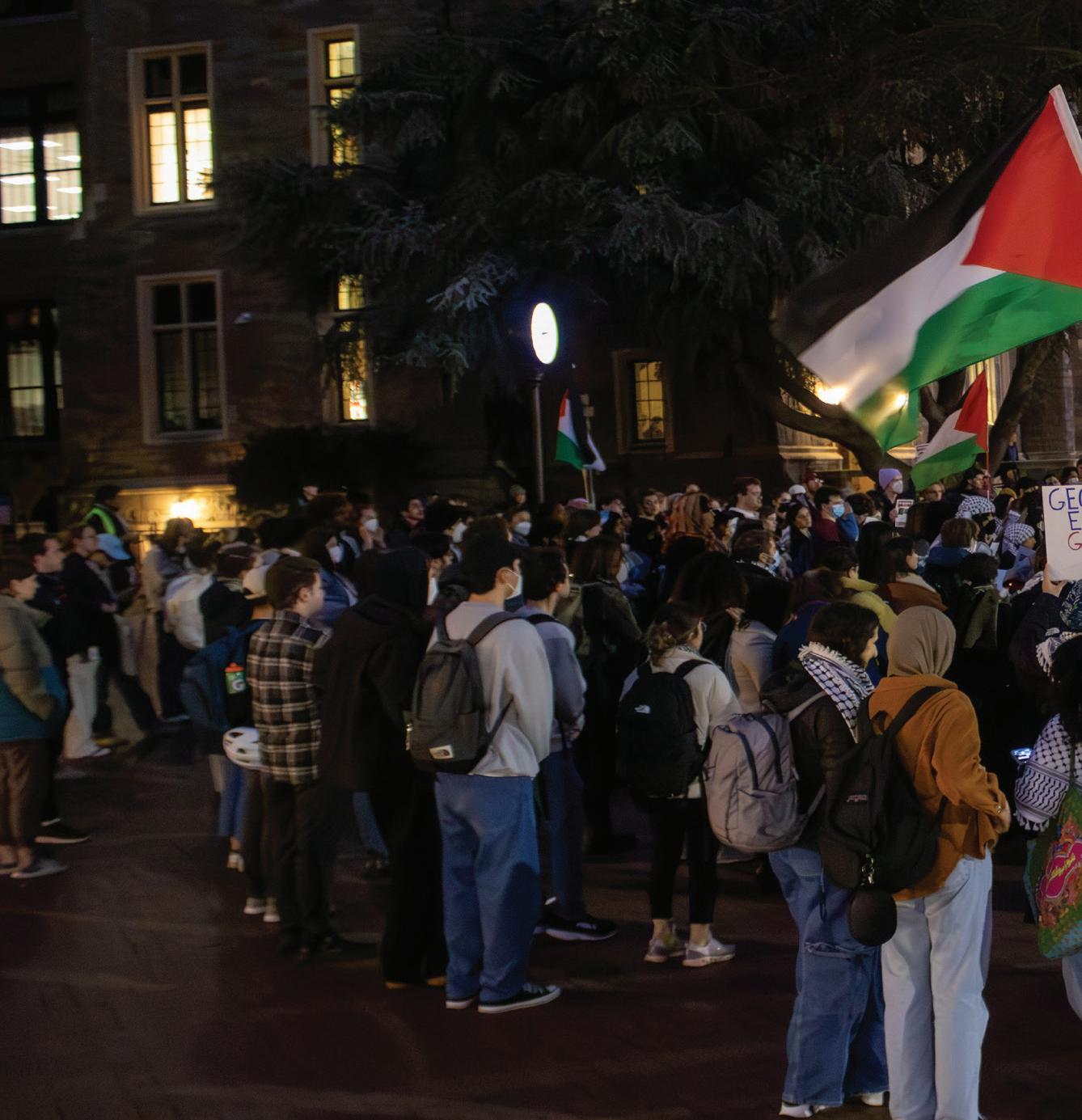
4 THE GEORGETOWN VOICE NEWS photos by connor martin and eddy binford-ross
Jewish Life and Israel Alliance with IDF soldiers
FRANZISKA WILD, AND SYDNEY CARROLL
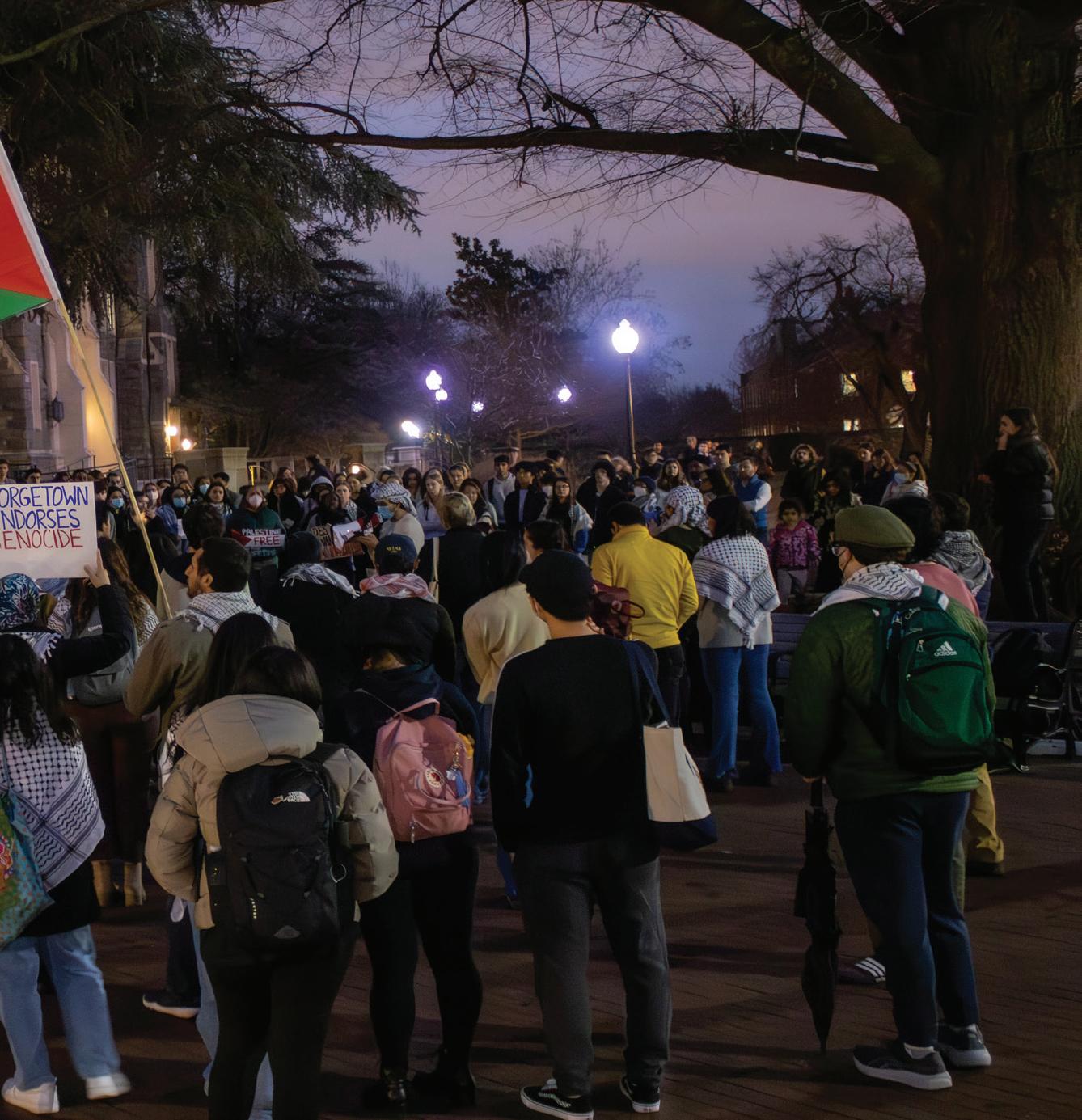
rows of the auditorium. The protesters wore keffiyehs and held up their hands, painted red, for the duration of the event. They also held signs opposing the event and turned their backs to the panel during rounds of applause.
On multiple occasions, Cherlow and Eisen directly addressed the counterprotesters inside, as well as those they had seen earlier in Red Square.
Cherlow discussed the counterprotesters and the red paint on their hands. He said protesters did not know the action’s symbolism. Standing at the podium, Cherlow pulled up a photo on his phone of a man who participated in the 2000 lynching of IDF reservists in Ramallah holding up his bloody hands.
Counterprotesters said their choice was not in reference to that event.
“The red paint on the hands has been a pretty common protest strategy in this movement, and in many other movements not specific to Palestine, as a reminder that the speakers—the people in front of us—they have blood on their hands,” Siegel said. The symbol has been used frequently in protests in the last few months, as well as in other anti-war movements.
Cherlow then went on to call the protesters out for wearing keffiyehs, traditional Arab headdresses that can also be worn as a scarf.
“They having keffiyeh, the shawl. They don’t know what is the symbol of this. It’s symbol of Arafat, of Nakba, of terrorism,” Cherlow said.
The black and white variety of the keffiyeh has become a symbol of Palestinian culture, as well as the struggle for a Palestinian state. According to an Associated Press report, the keffiyeh is “not a symbol of ‘Hamas terrorists,’” but of solidarity with Palestine.
Eisen also addressed the protesters in the back of the room, asking if any of the protesters spoke the language. He then remarked, in Arabic, that not a single one did—after which a protester shouted an Arabic insult. Eisen continued, saying that the Palestinian people know very well that Jewish people are better for them than Hamas. He also added that if the Muslims would welcome Jewish people, then the war would end, but if not, they were prepared to fight until the end.
He continued in English, “Since all the people raising their hands don’t know what I’m saying—I want peace.”
At this moment and others, counterprotesters said they felt as though Eisen and Cherlow were attempting to shame them.
“Their goal in addressing us is to try and humiliate us and demean us,” Siegel said. “I think that did not work. I personally felt so strong, hearing the groups of people outside chanting.”
Towards the end of the event, counterprotesters began to walk out one at a time. As they left, some flipped off the panel and each shouted phrases, including “Shame!” and “I’m Jewish and I stand for Palestine!”
In interviews with the Voice, event organizers raised concern that counterprotesters’ actions may have violated Georgetown’s free speech policies. A Student Affairs official present for the event said they believe that none of the conduct violated existing policies on free expression. They said students generally respected the directions given by university officials throughout the evening.
After Jewish Life made a social media announcement about the panel on Feb. 23, student groups organized against the event online. JVP, SPJ, and Zeytoun co-authored one petition, which was signed by over 500 students and alumni as of Feb. 28. The petition called the event “profoundly inappropriate” as well as “dehumanizing and despicable.”
Another petition, signed by 30 Jewish students, alumni, and staff as of Feb. 28, questioned Jewish Life’s hosting of the panel. The petition said that as a result, the signatories no longer felt represented in Georgetown’s Jewish community.
This online activism culminated in the Feb. 27 rally. At the Red Square portion of the rally, organizers also held a moment of silence for Aaron Bushnell, a U.S. Air Force member who fatally set himself on fire on Feb. 25 at the Israeli Embassy in protest for a free Palestine.
“I am in so much pain that this community that is meant to serve as my home, meant to make me feel safe, is inviting soldiers who could have potentially killed my family,” Selina al-Shihabi (SFS ’26), a Palestinian American organizer with SJP, said at the rally. “I have no words.”
Echoing the petitions, protesters also decried the involvement of Jewish Life and Campus Ministry during the rally.
“We're very disturbed that Campus Ministry would invite soldiers involved in active human rights violations to campus,” professor Mark Lance, a member of FSJP, said in an interview with the Voice. “With this specific and immediate event, I would like [the university] to reflect upon and perhaps introduce some procedures for who gets the imprimatur of Campus Ministry.”
During the demonstration outside the Hariri building, protesters directed their words—like “Israel bombs, Georgetown pays”—towards the building and the event itself. The chants of counterprotesters could be heard inside the event.
GUPD officers stood outside of the auditorium and the perimeter of the Hariri Building throughout the protest; at least two were holding fire extinguishers.
“While the majority of protesters acted in accordance with Georgetown’s Speech and Expression Policy, those who received warnings from Georgetown staff members but continued to violate policies were asked to leave. At this time, GUPD has made no referrals to Student Conduct related to Tuesday night's event,” GUPD chief of police Katherine Perez wrote in an email to the Voice on Feb. 28.
For Palestinian students, the event marked another incident in which they’ve felt unheard by school administrators. Al-Shihabi said the campus she used to call home now feels like anything but.
“All I do is speak and speak and speak about why my humanity and my people should be allowed to simply exist,” al-Shihabi said at the rally. “I no longer feel comfortable on this campus, and this administration does not fucking care.”

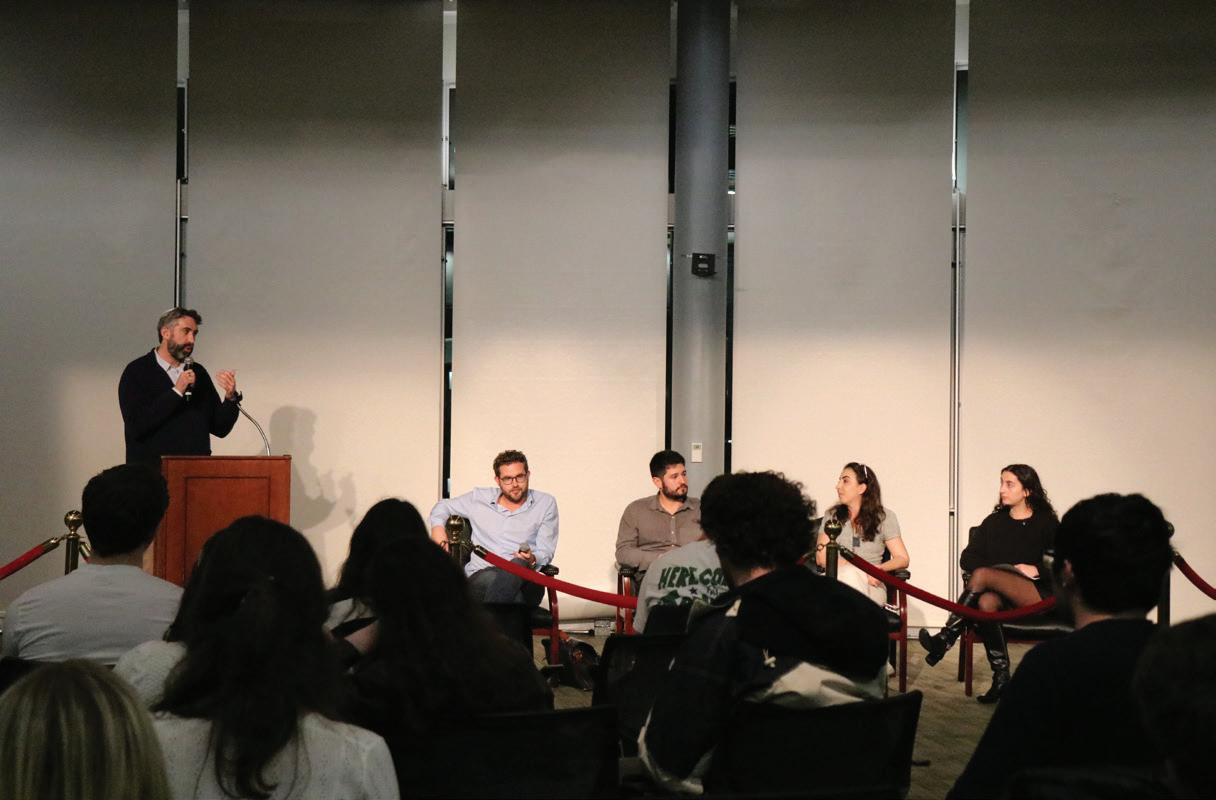
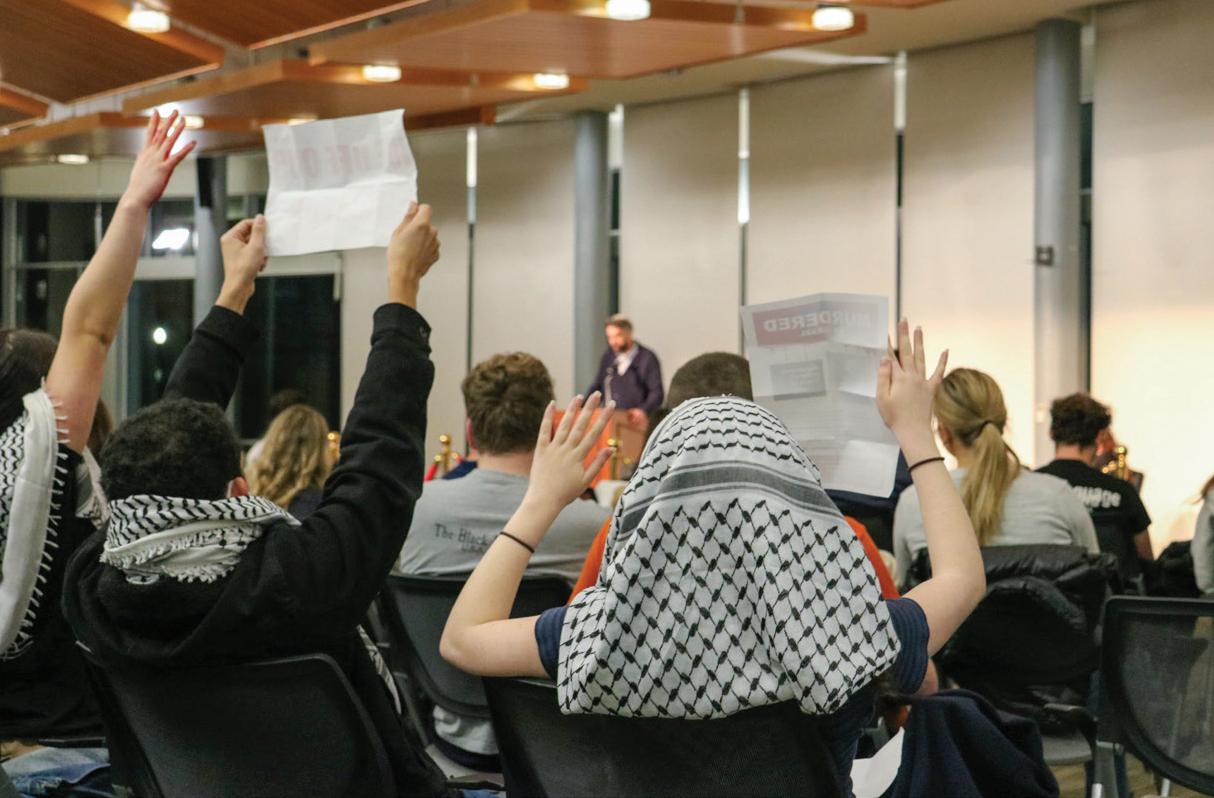
5 MARCH 1, 2024 design by connor martin
Put a bow on it: A blissful reclamation of “coquette”
BY ALEXANDRA LALLI
Content warning: This article includes references to pedophilia.
Ifirst encountered the word “coquette” while reading Lolita by Vladimir Nabokov. The novel follows a middle-aged narrator, under the pseudonym Humbert Humbert, and his lustful pinings for the titular 12-year-old girl. It was revolting not only for its disturbed content but also for its ambiguous rhetoric. Because the novel is told through Humbert’s perspective, it reads defensively, attempting to extract pity for a pedophile—and I have no interest in granting any moral grace to predators.
After shoving the book to the depths of my bookshelf, I assumed I’d never have to think about that piece of perversion again. And yet, years later, when Instagram and TikTok became flooded with bows in theme with the “coquette trend,” I was immediately reminded of Humbert's slimy voice, begging Lolita to release him from her “coquettish temptation.” The trend itself is innocuous: put bows on anything and everything from Britas to headphones, boyfriends, and even chicken nuggets. Besides its name, the trend has little in common with Lolita or anything remotely deviant. Still, it’s not the “bow” or “pink” style. It’s the “coquette trend,” but I’m not sure whether those partaking in the trend understand why.
The word “coquette” traces back as far as 1611, defined as “a woman who trifles with men’s affections; a woman given to flirting or coquetry.” This definition already has questionable undertones; it sets the expectation that a woman owes something to men by simply engaging with them and accepting his “affections.” It seems the word coquette has always been aimed at vilifying women. This rhetoric becomes even more problematic considering that “coquette” is most often associated with little girls, Lolita being the ultimate poster child.
Clearly, the trend’s namesake has inherently sexist and perverted origins. Yet, it seems ignorant of its seedy history. The only real remnant of these darker tones can be found in the music videos for the song “Let The Light In” by Lana Del Rey, featuring Father John Misty. Lana is known for glorifying tortured femininity in her music. While this romanticization may come
across as problematic, Lana purportedly melds beauty and distress to make a statement about the relationship between femininity and pain.
She writes songs for the “female manipulator,” whose narrative men have always held sole license over. She even has a song titled “Lolita,” where she plays the Nabokov character, beckoning her listener to kiss her in the park. It’s uncomfortable because Lana fleshes out the male perception of a “Lolita”: a young seductress acting upon impulses far beyond her age. However, the song's lyrics and nursery rhyme lilt emphasize a tone of youth and naivete, which only becomes an issue when men pervert those innocent desires for their own manipulation.
Based on her discography, Lana seems conscious of the origins of first encountered the word “coquette” and the general distortion of femininity. At one point, the coquette trend was knowledgeable of this, too. Why else would it be associated with Lana, the poster child of the “female manipulator”? But the internet has since diluted the trend, shedding any profound connection to its name. The “coquette aesthetic” now consists of anything pastel, frilly, and dolllike, often described as a kind of hyperfemininity. Some could argue that this way of dressing is similar to what Nabokov envisioned when he dreamt up the “coquette woman”: a young girl who uses her feminine aesthetics to attract and ensnare the men around her. But the idea that women want to dress well to be desired is entirely concocted by the male gaze, and it shouldn’t be. Shouldn’t women be able to be feminine without bringing men into the conversation?
There have been trends that more blatantly refer to coquette’s darker origins. In Japan, there exists an entire fashion subculture titled after Nabokov’s nymphet. The “Lolita fashion” mirrors the coquette aesthetic to a saccharine degree. Frills and porcelain makeup signal the cosplaying nature of this trend: that of the childlike, vulnerable girl—the Lolita. However, the Japanese Lolita aesthetic uses dark undertones—chains, black hues, and leather—to display the suffocating nature of femininity. By physically expressing the more insidious elements of coquette, they illuminate how the pressure of femininity can turn women into ideas, inextricably tethered to a perverted male fantasy. But there’s a cost to their approach. In choosing to make such an overt statement, these women dedicate their lives to representing themselves in the exaggerated male gaze, rather than trying to move beyond it.
By comparison, the “coquette aesthetic” seems like a much quieter voice in this conversation of twisted femininity. Yet, perhaps it doesn’t need to be a voice at all. I appreciate the awareness of trends like Lana’s “female manipulator” and the Japanese “Lolita aesthetic.” Making bold artistic statements is essential for cultural dialogue. However, they come with setbacks. In choosing to take a more combative approach to reclamation, these trends and artists risk reinforcement of the harmful stereotypes that they are trying to dismantle.
For years, women have been indoctrinated to think they owe a part of their femininity to men, thereby forcing them to employ a kind of double consciousness: balancing what they want and like with how that will be subjected to male scrutiny and violence. Because of this hyperawareness, the choice to emphasize one’s beauty or show a little more skin is assumed to have ulterior motives, and therefore, a reason to blame women for unwanted attention. This pressure is sadly linked to the “coquette" trend, as the word was ultimately created by men to justify their mistreatment of young women. Part of the reclamation process requires the acknowledgment of the past in order to properly rewrite it; yet, reclamation also requires moving forward.
The coquette trend is unique to me because it aims to separate femininity from the male gaze. Today, when girls put bows on their water bottles, wear pink, and muse at how “coquette” everything is, they are thinking about themselves. They’re embracing femininity because it makes them feel happy, and I think that’s its own kind of reclamation.


6 THE GEORGETOWN VOICE VOICES design by pia cruz





The inherent desire to make our writing sound as sophisticated and scholarly as possible has likely been ingrained in all of us throughout our academic careers. I often get excited when I can throw a fancy vocabulary word in a paper, eager to boost my credibility and impress my professor—who can resist the urge to use words like “myriad” or “ubiquitous” when they have the chance? However, in reality, the overuse of superfluous vocabulary (see, I just did it!) doesn’t have the effect you may think. There is a distinct need in our community and the world beyond to make our writing as clear as possible, an approach known as plain language. In this case, less really can be more.
So what is plain language? Pretty much exactly what it sounds like. Plain language is concise communication that your audience can easily understand the first time they read or hear it. Plain language doesn’t mean oversimplifying the content of your writing. You’re not changing what you say, but how you say it—typically with fewer words and simpler terminology. I could argue that it would greatly behoove the Georgetown community to decrease our utilization of unnecessarily convoluted rhetoric, or I could state that the Georgetown community should use plain language.
It can be as simple as making a few sentence-level changes: choose common words instead of flaunting an impressive vocabulary, shorten your sentences by sticking to one idea per sentence, and challenge the purpose of every word. More broadly, it’s crucial to identify your audience. Writing for kindergarteners? Use language they will be able to understand. Addressing a group of experts about a topic in their field? Feel free to be more specific and use appropriate terminology while still employing principles that keep your language accessible to readers.
These are only a few strategies promoted by the federal plain language guidelines, all of which aim to help you share your message with as much clarity as possible.




You may be worried that using such basic language will make you seem less smart or fail to impress your audience. This is a valid concern, considering the overly complicated language that is all too prevalent in academia. Georgetown’s undeniably competitive environment also adds to this pressure—many of us have likely been insecure about our writing skills in comparison to others’, or felt a dire need to get the best grade on a paper.
However, the opposite is true: plain language makes you look smarter. If people easily understand what you’re trying to say, they won’t be left frustrated or misinterpret your message. It actually requires you to be smarter, too—successfully explaining something in simpler terms requires a deeper understanding of that topic. Imagine describing a complicated concept you learned in your biology class to your friend who’s a history major. If you can do it in a way that makes them get it easily, you clearly know your stuff (and your friend will think so too). Plain language not only strengthens your point, but allows you to express it as smoothly and efficiently as possible.
Beyond our personal lives, plain language is critical from an accessibility perspective. Writing, particularly in an academic context, is often made inaccessible to those who may not be able to understand the nuanced discourse of a particular topic. People with cognitive disabilities, lower reading levels, or unfamiliarity with a certain subject can all feel alienated from advanced scholarship, and they may benefit from simpler language. This also applies to non-native English speakers for whom plain language can be crucial in everyday life, from reading signs to gaining an education.
Consider some of the many real-world benefits: plain language can be used in prescription medicine instructions to prevent misuse, in the legal system (it’s pretty important to know your rights), and in the worldwide sharing of information. During the height of COVID, more accessible language may have helped people better understand emerging safety guidelines, such as proper quarantine and social distancing protocols.

It could have demystified the confusion and controversy surrounding vaccines and consequently prevented deaths. Any writing, from dense academic texts to confusingly worded emails, is made inaccessible to many when it lacks clarity.
So, how do we go about implementing this in our world? We can’t go back and edit the overly complex works of renowned authors and theorists, nor can we vow to simplify all language in all contexts. Certain academic disciplines may require or prefer such language, but this doesn’t exclude them from finding ways to make their content more comprehensible. The key to making information accessible to all is to use plain language anywhere we possibly can. This can be as straightforward as making a few small changes at Georgetown, like employing simpler language in schoolwide emails, university websites, course syllabi, and assignment instructions. We can extend it to academia as well through plain language summaries or plain language versions that serve as helpful additions to the original content. These can make complicated works (like scientific articles or dense works of theory) easier to understand, increasing their ability to reach all students and the general public.
As difficult as it may seem, I challenge you to resist the urge to overcomplicate your writing just to “sound smarter.” More importantly, I challenge the broader Georgetown community to recognize the necessity of accessible language and to implement it in your own writing and communication in as many ways as possible. It’s for our own good: any information worth sharing within a community should be easily understood by all.

design by ryan goodwin 7 MARCH 1, 2024
On 16th and U streets, neighbors push for equity in rezoning
BY SAM MONTEIRO AND FRANZISKA WILD
At 1617 U St., a two-acre parcel of public land sits at the center of a dispute between the local community and two government agencies. Though the debate centers on a simple question of rezoning, it’s archetypal of a difficult issue long plaguing D.C.—how to create more affordable housing while balancing development and displacement.
Against neighbors’ wishes, the Office of Planning (OP) and the Office of the Deputy Mayor for Planning and Economic Development (DMPED) are trying to rezone the property location, which would allow larger buildings, including luxury housing units, to be built on the site.
Currently home to an active police and fire station, the lot is nestled among residential buildings along the 16th Street Historic District. DMPED’s 2021 Comprehensive Plan envisioned this parcel of land as “high density mixed-use,” or any type of development from residential high-rises to luxury lofts. Despite the plans to rezone, DMPED does not currently have a concrete plan for the land, although they have promised the community the public safety services headquartered at 1617 will remain there regardless of what else is added to the lot.
In line with this vision, the OP is pushing for the site to be upzoned from its current MU-4 zoning to a higher MU-10 zoning, allowing for the eventual structure at the site to be 90 feet tall—a 40-foot jump from the current zoning restrictions. But residents believe the proposed rezoning could allow for luxury development on the lot that would raise the area’s rent prices, leading to the displacement of current U Street residents. Gentrification is a concern for many residents of the U Street Corridor as developers look to the neighborhood to build luxury housing, like the Ellington apartment building on 13th Street, that attracts wealthy newcomers.
Although zoning laws can be a mundane issue, the proposed upzoning has incited fierce opposition from neighbors and community groups. The pushback centers on concerns about gentrification and the height of the proposed zoning, which critics say could appear out of place with the historic nature of the neighborhood.
One main point of contention: how the OP and DMPED have conducted the zoning process. Neighbors and community members feel as though both offices have shirked their responsibility to sufficiently engage the community.
Gregory Adams, who lives on 17th Street, a couple of blocks away from the proposed rezoning site, is one of these neighbors. Adams represents Black Neighbors of 1617 U Street, a key party in opposition to the rezoning.
He described going door-to-door to inform his neighbors after he heard about the proposed project via the “neighborhood grapevine.”
“I heard the same thing from everybody: that they had not been contacted by anyone. Some of my neighbors are older than I am,” Adams, who is in his 70s, said. “These are not people who are going to go out to [Advisory Neighborhood Commission] meetings, they’re not people who are going to go online to do Zoom meetings, but they will talk to people face-to-face, and there had been no outreach to any of them.”
DMPED has participated in over a dozen meetings with the Advisory Neighborhood Commissions (ANC) representing or bordering 1617 U St. The OP also presented at ANC meetings in October and November of last year. A representative wrote in a statement to the Voice that it has “conducted outreach in accordance with the Zoning Commission’s Racial Equity Tool.”
That tool requires that rezoning applicants engage in community outreach to understand the potential impact of the new zones on issues like housing affordability and resident displacement— both of which have a disproportionate effect on people of color in D.C.
D.C. Zoning Commission Chairman Anthony Hood oversees the public hearings for the zoning case, where government officials and residents have discussed the potential plans for the site. Hood noted the OP’s lack of outreach to residents at the Jan. 18 hearing.
Many community members also agree that this outreach is insufficient.
“No meaningful outreach, such as producing flyers, canvassing, social media engagement, and posting hearing notices, was conducted with our church,” wrote the Freedom Baptist Church, which is roughly two blocks away from the site, in their opposition letter to the Zoning Commission.
Deborah Akel, who has lived at 1603 U St. for the last 15 years and shares the property line with the lot, feels similarly. Although the OP provided notice to the property owner of her building (the office is required by law to notify properties within 200 feet), her landlord didn’t pass this notice on to her. She described reaching out to the city herself to set up opportunities to learn about the rezoning.
“I had to instigate these meetings. I had to organize them myself,” Akel said.
Other opposition parties also cited a lack of outreach and, despite DMPED’s aggressive goals around affordable housing, a lack of faith that the city will use this public land to create more affordable housing.
“To date, details have been held back, impact studies have not been conducted, and thus potential impacts have not been identified for mitigation, and a long-term vision has not been discussed with affected residents,” the ShawDupont Citizens Alliance wrote in a letter to the Zoning Commission.
After a similar project raised property values, the landlord of Akel’s rent-controlled building in West End sold the building. That sale displaced Akel from her previous residence of 15 years, and she now expresses serious concerns about the parallels between her experience of displacement there and the proposed project at 1617 U St.
“I think that this could transform the U Street Corridor and lead to a lot of displacement,” she said. Other U Street Corridor residents expressed similar concerns.
DMPED maintains that although the rezoning process is currently underway, there is no concrete vision for the use of the land because they have not yet finished the Request for Proposals (RFP) process—a process that allows for community input on new developments. As a result, there’s no knowing what could even be built there in the first place.
“We are still in the very early planning phases of this project, and significant community input and engagement is still to come,” DMPED wrote in a statement to the Voice
In response to similar statements from DMPED, Akel and several others question why rezoning is even necessary.
“Zoning keeps saying, ‘There’s no project,’ but then why do you need MU-10 if there’s no project? Why are you asking for maximum height and density if there’s no project? Why are you putting the cart before the horse?” Akel said.
Andria Chatmon, an organizer with Empower DC, an organization that advocates for affordable housing in D.C., has been collaborating with neighbors who oppose the project to bridge some of the alleged gaps in the OP’s outreach through direct community engagement work. She has talked with residents like Akel and Adams who fear displacement, as well as those who express concern about what upzoning might do to the historic character of the neighborhood.
These myriad concerns take place against the backdrop of the historic displacement from property development in D.C., especially for the District’s Black residents.
Peter Tatian, a research fellow at the Urban Institute whose work focuses on housing policy and affordable housing preservation, published a report after the release of the 2020 Census that showed a 3.8


8 THE GEORGETOWN VOICE NEWS graphic by olivia li; layout by elin choe
percent decrease in D.C.’s Black population over the last decade.
“Displacement of Black residents from D.C. is something that's been happening for a long time. It actually started in the late ’60s and has continued to this point,” Tatian said in an interview with the Voice.
Since its peak in 1970, the Black population of D.C. has decreased by over 240,000 residents. By the end of the 1990s, economic factors exacerbated by gentrification made D.C. increasingly unaffordable to existing Black communities.
“[Black residents] face more displacement because of new developments and rising costs,” Tatian said. “Many Black residents in D.C. don’t have the means, the income that allow them to stay.”
The median income for Black D.C. residents is $49,652. With median rent prices above $2,000 per month, market-rate housing in the city is often unaffordable. White D.C. residents, on the other hand, earn a median income of $149,734, making them less likely to be displaced by rising costs of living.
Adams has lived on 17th Street for the last 40 years and said she has witnessed this trend firsthand.
“This was a thriving Black community when I moved here in ’84, and here in 2024 I am the last Black household on our block,” Adams said.
“As James Baldwin said in a 1960 speech, ‘urban renewal means Negro removal,’ and that has always seemed to play out, whether intentionally or not,” he added.
The potential for new luxury developments as a result of the 1617 U St. rezoning is
especially worrisome for a community that has already experienced changing neighborhood demographics as a result of rising rent.
“I don’t know all the reasons why the neighborhood has changed. I do know that some of my neighbors were forced out because of rising rents, and I don’t see how a new development on that site would correct that. I don’t see how it doesn’t exacerbate it,” Adams said.
Dr. Tanya Golash-Boza, a D.C. native, professor of sociology, and founder of the Racism, Capitalism, and the Law Lab at the University of California, Merced, submitted an expert testimony to the Zoning Commission about the case. In her statement, she detailed five instances where other parts of D.C. saw a significant decrease in Black residents following a change to the MU10 zoning designation.
“[T]he area in the West End near 24th and M, which had a few hundred Black residents 15 years ago [has] no Black residents today,” Dr. Golash-Boza wrote in her testimony. “An area in Navy Yard was also upzoned in this way. This area was nearly all Black before the public housing was demolished, and is only 10 percent Black today.”
Although there are currently no residential properties at 1617 U St., many residents are calling for more affordable housing to be built there to prevent further displacement.
“If the government could take land from Black people and transform it into public land, there is no reason it can’t take this lot of public land and transform it into a place
where Black people can live and thrive,” Dr. Golash-Boza wrote.
Community members have proposed constructing social housing on the lot, a type of development that offers a variety of affordable price points for tenants who may not be able to afford traditional housing units.
The spread of social housing has gained traction in the District recently. In 2022, Ward 4 council member Janeese Lewis George introduced a bill to mandate social housing prices in one-third of all new properties.
Several residents expressed their support for this idea at a public Zoning Commission hearing on Feb. 12, as well as through written testimonies submitted throughout the public hearing period. Hood said at the hearing that the Commission has been discussing the possibility.
“The Zoning Commission has already been having conversations [with] Councilwoman Lewis George about social housing, so I want you to know that we’re not just sitting back asleep,” Hood said. “She and I have spoken about that on a number of occasions, and how we can institute it.”
Over one in 10 D.C. residents are facing housing insecurity, mainly due to unaffordability and inadequate housing. Many neighbors of 1617 U St. feel that the District now has an opportunity to build more equitable, affordable housing there so that fewer people are forced to move by rising housing prices in the future. Adams, for one, sees the potential for the lot.
“Since there’s no housing there now, if you’re going to put housing there it should be in-scale first of all, and it should be really affordable housing,” he said.


MARCH 1, 2024 9
Old legacies, new approaches: Reworked diversity requirement to take e ect next year
BY CAROLINA BOMENY

What does it mean to receive an education from Georgetown, not despite but given the school's history? A new one-credit seminar titled Race, Power, and Justice at Georgetown tries to help students answer this question. A 50-student pilot program of the course concluded on the week of Feb. 20, and the Fall 2024 semester will be the first time the class is required for all new students as part of the new Pathways to Social Justice (PtoSJ) requirement.
The interdisciplinary course will introduce new students to issues of race and their correlation to power and identity on campus and beyond. Beginning with the university's history of slavery, the class will explore Georgetown's relationship to D.C. and the world with the goal of understanding what justice—one of Georgetown's core principles— means in practice.
“The real intention of the course is to get students to understand and begin to grapple with some of the ongoing histories of inequality at Georgetown really focused on, of course, race, which is in the title, but even more broadly, thinking about what inequality and social justice looks like and how it's played out on Georgetown's campus,” SFS professor Arjun Shankar, who helped design the new PtoSJ requirement, said.
In addition to the freshman seminar, offered twice every semester, students will have to take two three-credit courses that meet at least three of the five PtoSJ priorities: inclusive scholarship; intersectional approaches to identity; historical legacies of inequality and their contemporary impacts; national, regional, and global comparisons; and imagining justice. PtoSJ replaces the former Engaging Diversity requirement.
Sociology professor Carla Shedd believes the seminar intentionally prepares students for the rest of their requirements.
“This facilitates the students getting a foundation, and then when they take other courses, it's not like, ‘I just so happened to take a class that dealt with diversity,’” Shedd said.
Seven professors representing all four undergraduate schools taught in the pilot program, structured around a weekly speaker
event followed by smaller discussion groups. Guest speakers ranged from Mélisande ShortColomb (COL ’21), a GU272+ descendant, people involved with Georgetown's Prisons and Justice Initiative, campus ministry leaders, and more.
For Annie Kane (CAS ’24), the class has been an opportunity to reflect on her Georgetown journey.
“As a freshman, it would have made me think more intentionally about what kind of different clubs and organizations I would have wanted to join on campus that could be oriented towards this kind of work,” Kane said.
Chantal Li (SFS ’25) says she would take the course every semester if she could and found its emphasis on defining core racial concepts to be essential.
“It was very important, especially for the conceptualization of this class, to understand how to think about racism, racialization, ethnicity, so on and so forth, in order to have a better understanding of how we should approach the issues that we're talking about more critically,” Li said.
Although Li thinks six weeks is not sufficient for the course, as every week's subject could provide content for monthlong conversations, she's excited for students to be introduced to these concepts early in their Georgetown journeys.
“I have a lot of freshmen in my discussion section, and they bring such interesting questions to the table. They're so curious to learn more about it, and it just makes me really happy and hopeful for the future direction of how Georgetown is thinking about the education that it's bringing to its students,” Li said.
The pilot program will inform the course’s future through student feedback. While student reviews have been positive, faculty acknowledge that this cohort was self-selecting.
“I think next year, there will be students who are there only because it's required, who may have suspicions of what the purpose of the class is," professor John Kraemer, who taught in the course, said. "I hope that this is a place where we can have those conversations in the open, because I think that they will bring something important to the dialogue.”
Scaling the course to the entire first-year class next semester—a 350-student jump—is a challenge on its own.
“Part of the problem is just space. We can barely squeeze everybody who's supposed to take the class into a room as it is,” professor Adam Rothman, the class's coordinator, said.
The challenge only grows if the course, like the pilot, is taught synchronously with the Doha campus.
“Qatar is actually on a different academic calendar than we are,” Rothman said. “I think if we can make it work, it's gonna make this class just a great opportunity for very diverse students to come together in a way that doesn't usually happen.”
Making the course relevant beyond the main campus has required faculty to innovate and approach the course with a broader lens.
“When we're talking in the class about reparations, we don't want to just talk about reparations in an American context. We want to talk about reparations in a global context,” said professor Jeremy Koons, who teaches in Doha.
One of Koons's students, Jemimah Golo (GU-Q ’26), feels as though the class helped shape her perspective on race, even as someone who didn't grow up in the U.S.
“Nigeria is predominantly Black … so I didn't grow up knowing, ‘Oh, I'm Black.’ I grew up knowing I'm Jemimah. So even the class is helping me learn my identities and learn ways in which my identity shapes the world,” Golo said.
She hopes that the class will spark conversations within the school. “I think to Georgetown Qatar specifically, there's a level of discretion when it comes to things race-related because we're all diverse,” she said. “I think it will force Georgetown Qatar to become not just more aware, but have those uncomfortable conversations inside and out of class.”
For Shankar, the implications of this course, alongside PtoSJ, go beyond the classroom.
“It's going to become a core for why students are going to want to come to Georgetown. To be at a school that actually takes seriously questions of race and social justice the moment you walk through the door, it's going to set it apart from most universities in the United States, and that's a big deal.”
10 THE GEORGETOWN VOICE NEWS design by sabrina shaffer; photos courtesy of georgetown library archive and georgetown slavery archive
Ensure Georgetown workers get what they deserve
BY THE EDITORIAL BOARD
Student-worker solidarity requires continuous action. This editorial board calls on students to support dining workers in their upcoming contract negotiations with Aramark. The negotiations will begin on March 6 and last until Unite Here Local 23, the union representing main campus dining workers, and Aramark, the university’s subcontractor for dining services, reach a new agreement. During this time, students should vocalize support for workers and pressure Aramark to enact workers’ demands for higher wages, improved healthcare cvoverage, and safer, more inclusive working conditions.
Georgetown relies on subcontracted labor as a way to shirk managerial responsibility and distance itself from the needs of workers. However, the university is still required to hold contractors like Aramark accountable and protect the rights of subcontracted workers. According to the Just Employment Policy, Georgetown must ensure that university employees and full-time contract workers are guaranteed fair wages, a safe and harassment-free work environment, and the right to unionize.
Despite the Just Employment Policy, the university chooses not to involve itself in union negotiations. “When workers are in a union, the university refrains from interfering in their labormanagement relationship, which is contractual and is subject to periodic renegotiation, as is happening this spring with the Aramark workers,” Joseph McCartin, executive director for the Kalmanovitz Initiative for Labor and the Working Poor, wrote in an email to the Voice. Still, the university possesses influence over how Aramark treats its employees—and more significantly, an ethical responsibility to use it.
Georgetown entered its contract with Aramark in 2008 amid widespread protests calling for better treatment of Aramark employees. At the time, the food service company had an abysmal labor rights record, which has only worsened in years since. Beyond its partnerships with universities, Aramark is also the largest provider of food services to U.S. prisons. It has been repeatedly accused of severe health and safety violations, exploiting unpaid labor, sexual harassment, and employee misconduct in the prisons it operates. Workers frequently sue Aramark in class action lawsuits over labor rights violations including unpaid wages and unpaid overtime.
In 2016, Georgetown’s contract with Aramark was set to expire. Students vocalized strong opposition to the proposed contract renewal and circulated a 2,000-signature petition, which cited Aramark’s extensive labor rights violations.
Despite student protest, Georgetown decided to renew its contract with Aramark for the next 10 years, which underlines the university’s lack of substantive commitment to labor rights. If Georgetown wants to embody the Catholic value of dignified work, it should not continue to partner with a company that participates in labor exploitation, upholds the prison-industrial complex, and profits off of workers’ rights violations. Because the university knowingly kept a corrupt contractor in our campus community, it has an even greater responsibility to protect dining and facilities workers.
The university’s current contract with Aramark will expire in 2026. Georgetown should leverage the extension of that contract to ensure Aramark complies with workers’ demands in their upcoming contract negotiations. Since dining workers’ last contract negotiation with Aramark in 2019, dining workers have faced new challenges that threaten their health, safety, and livelihoods. It is imperative, therefore, that Georgetown ensure Aramark management meets these demands.
Firstly, workers have voiced concerns about wages. While contracts between the union and Aramark can last several years, the cost of living continues to rise. Thus, new contracts must include a wage that expressly keeps up with the cost of living like those secured at peer institutions in recent years. Dining workers have also expressed frustration that they are ineligible to receive pay when the dining hall is shut and the university is out of session. Additionally, their current contract includes only six sick days and does not include paid time off. This is especially problematic given the prevalence of COVID-19, which may require workers to quarantine for several days.
The current contract with Aramark has also failed to protect workers’ physical health and access to health benefits. Under the Affordable Care Act, Aramark is required to provide healthcare coverage to all full-time employees but is not required to provide coverage for part-time employees. According to members of Georgetown Coalition for Workers’ Rights (GUCWR), employees have reported being scheduled for just under 30 hours, rendering them ineligible for health benefits, despite expressing a desire to work full-time. Not only does this practice put dining workers’ health at risk but it directly opposes a provision in the Just Employment Policy ordering the university to provide “part-time or temporary work only when necessary.”
Dining workers also face issues with safety, hygiene, and inclusion in the workplace. According to members of GUCWR, dining workers have reported only having access to cold water in certain
services, making it impossible for them to properly clean dishes. Workers have reported rats in their break rooms, which are located next to trash bins, posing serious health threats to both workers and students. Finally, workers who identify as gender nonbinary do not have access to gender-neutral changing rooms and restrooms, a policy that is in violation of Georgetown’s non-discrimination policy. On March 6, Unite Here Local 23 will begin advocating for these demands, among others, in the new contract with Aramark.
Drawing on the Jesuit tradition of worker justice, Georgetown claims to champion labor rights. And while the university has made important efforts to protect workers—like the Just Employment Policy—these advancements have only been made possible through student-worker organizing. Georgetown students must again show up for workers in this way, whether it's through attending GUCWR meetings, involving themselves in campus protests, or raising awareness on social media. Students should form relationships with dining workers and treat them with the same respect other members of the Georgetown community receive.
Dining workers, and all workers contracted by Aramark, are valued members of the Georgetown community and deserve protection and support. The university must stand for the dignity of work and ensure workers’ demands are addressed in the union’s new agreement with Aramark.
11 MARCH 1, 2024 EDITORIALS design by jihoo yang
From house to hoedown: Beyoncé takes on country in surprise new singles
BY AJANI JONES AND IMANI LIBURD
We should be accustomed to surprises on Super Bowl Sunday by now—both on and off the field. And yet, Beyoncé—who’s no stranger to the surprise drop—still managed to shock fans and football dads alike with a jaw-dropping double announcement: two new country singles and the upcoming release of her next studio album, Act II (2024).
Going into the big game, fans were already speculating whether she had more tricks up her sleeve (or rather, her bedazzled glove). After all, Verizon had already been teasing a Beyoncé feature for their halftime ad, and it wouldn't have been the first time she’d gone big at the Super Bowl. Her 2016 Beychella-inspired performance of “Formation” alongside Bruno Mars had most viewers forgetting she was only a guest at Coldplay’s halftime show.
Staying true to her penchant for surprises, Beyoncé’s two new singles, “TEXAS HOLD ‘EM” and “16 CARRIAGES,” embody the superstar’s experimental spirit while departing from her past discography. Her 2022 exploration of house music on RENAISSANCE was a project steeped in queer Black joy that arguably sparked a mainstream resurgence of the genre. One-and-a-half years later, Beyoncé is taking on a different genre much closer to the Texas native’s roots: country.
Beyoncé has never shied away from flaunting her Houston pride, most evident in the cowgirlchic disco aesthetic of the “Renaissance World Tour” and her first rodeo with country on the experimental and genre-hopping Lemonade (2016) with “Daddy Lessons.”
On “TEXAS HOLD ‘EM,” Beyoncé gives audiences a taste of country music’s capacity to foster a sense of shared euphoria and call everyone to the dance floor. The single opens with a playful banjo melody that builds in rhythm and is complimented by the soothing raspiness of Beyoncé’s vocals. The backing instrumental remains lighthearted and bright, consisting of the steady strum of a guitar and a gentle drum beat—a faithful homage to the folk influences where country finds its roots. Beyoncé warbles a call and response with “This ain’t Texas / Ain’t no hold ‘em,” tapping into the joyful, infectious spirit of country to invite the listener to dance without reservation.
The vocals and the instrumentals crescendo in equal measure at the song’s climax before stripping down to a whistled melody. Beyoncé returns in a
soft, near-whisper: “And I’ll be damned if I cannot dance with you / Baby, pour that sugar and liquor on me, too.” The track is like a little bubble of Texas, the honey-sweet ending perfectly encapsulating the pleasant and homey characteristics of country.
Reflecting country’s multifaceted nature and sentimental qualities, Beyoncé moves away from the cheery country subgenre towards more emotional storytelling on “16 CARRIAGES.” Rumored to have been in the vault for a couple of years, this single takes advantage of Beyoncé’s poetic lyricism to recount her life story, making the track a melancholic and emotionally evocative listening experience like no other.
Fans have theorized that “16 CARRIAGES” is Beyoncé’s reflection on her ascent to fame at such a young age, with the title being a reference to her big break with Destiny’s Child at just 16 years old. Referring to her early years spent in the spotlight and the loss of her childhood, Beyoncé muses, “At 15, the innocence was gone astray / Had to leave my home at an early age.” Although she had made a name for herself at an impressively young age, the achievement came at the cost of her privacy and her youth.
As the song progresses, Beyoncé shifts the focus to her current struggles, emphasizing the heavy weight of her career: “Goin' so hard, now I miss my kids / Overworked and overwhelmed.” Despite starting from the bottom, Beyoncé has since achieved legendary status, and yet her quest to produce innovative and moving music is fraught with long-lasting battles and internal strife.
The track ends on a powerfully inspiring note. Regardless of the struggles she faces, Beyoncé will overcome all to leave her mark on the world: “The legacy, if it's the last thing I do / You'll remember me 'cause we got somethin' to prove.” Many may assume that, after decades in the game, Beyoncé’s reign is about to end, but mark her words—she won’t stop anytime soon.
No stranger to collecting awards, the 32time Grammy winner broke records on multiple charts with the release of “TEXAS HOLD ‘EM.” Not only was it the first time a woman went No. 1 simultaneously on both the Billboard Hot Country Songs and R&B/Hip Hop Songs charts, but it was also the first time a Black woman debuted at the top spot on the country Billboards. For as long as she’s been a musical powerhouse, Beyoncé has showcased her



Beyoncé’s 2024 turnaround from house to hoedown may feel jarring, but the move strikes a similar chord as she aims to return country music to its Black roots. Similar to genres like house, rock, and hip-hop, country music originates from an agglomeration of Black musical traditions, specifically ballads, the blues, and gospel. In his 2019 documentary Country Music, Ken Burns shares the stories of several Black country music pioneers whose legacies, although diminished by mainstream perceptions of country music as a “white” genre, are honored by everyday Black country artists and big names like Lil Nas X on his breakout single “Old Town Road” (2019) and, now, Beyoncé.
The tracks give fans a long-desired glimpse into what Beyoncé promises to deliver on Act II. From the upbeat, line-dancing melody of “TEXAS HOLD ‘EM” to the heartfelt ballad of “16 CARRIAGES,” Beyoncé signals her hope to give country the same tender love and care she gave house.
With the March 29 release date drawing ever closer, Beyoncé has made it clear that the next act of her three-act project will be an authentically country experience. While Act I: RENAISSANCE was a love letter to the Black and Brown queer roots of ballroom, Act II looks to be a triumphant transition to the smooth melodies and melancholic poetry of Black country. And to that, we say “yee-haw.”
12 THE GEORGETOWN VOICE HALFTIME LEISURE design by tina solki
Jacob Murrell is reaching new heights while staying local
BY ANDREW SWANK
Georgetown men’s soccer alumnus Jacob Murrell is only 19 years old, but he's already reached incredible heights in his soccer career. The standout striker, who was recently drafted by D.C. United of Major League Soccer (MLS), has rapidly risen through the levels of his sport, going from high school soccer to college, semiprofessional, and now professional soccer. Most unique about Murrell, though, is that he’s done all of it while staying local to the DMV.
Murrell was a highly-ranked recruit coming out of the McDonogh School in Maryland, where he scored 41 goals and was named the Gatorade National Boys Soccer Player of the Year in his senior year. Coming out of high school, he decided to stay in the DMV, committing to play college soccer at Georgetown.
Murrell had an outstanding career as a Hoya, scoring 18 goals and recording eight assists in his two seasons on the Hilltop. In 2023, he made the All-BIG EAST First Team along with four other Hoyas. For Murrell, though, the numbers and accolades weren't what made his time at Georgetown special.
“Whether we were winning or losing, it was just one of the closest groups I've ever been a part of, guys that I'll be friends with for life, which was really special,” Murrell said in an interview with the coaching staff at Georgetown, they’re the best people in the world.
They shaped me into being a good person as well as trying to reach the top level.”
Georgetown's men's soccer program is a national powerhouse, and during his time on the Hilltop, Murrell was one of the best players on one of the best teams in the country. Developing as a player, though, was only part of his journey as a Hoya.
“Obviously we're competing at the highest level on the field, but at the same time we're competing academically at one of the most rigorous universities in the country, or in the world,” Murrell said. “It was quite difficult to manage that at times, but it also helped us with time management, productivity, that type of stuff, which is really useful now as a professional athlete now with a lot more time on my hands.”
During the summer between his two seasons at Georgetown, Murrell took another step on his journey to the pros with another DMV soccer team—Annapolis Blues FC. The Blues are a semi-professional team in the National Premier Soccer League (NPSL) that played their inaugural season over the summer of 2023. Murrell was a key contributor to the team, scoring ten goals in ten appearances. One of his biggest moments as a Blue came in the Mid-Atlantic Conference Final, where he scored a game-tying goal in the dying minutes of regulation and the gamewinning penalty kick in the shootout.
“That was really different than playing for the club team growing up or the college team, because it was just a brand new team just being established,” Murrell said. “We were trying to lay the path for the future for the club, and they did a great job to put us as players into a position where we were playing in front of 7,500 to 10,000 fans, which was just quite incredible. It was something that I had never experienced in my life, and … I hope it will prepare me and make me a bit more relaxed when stepping in front of a bunch of fans.”

focused on adjusting to the MLS level of play in his first experience with a professional league. MLS is among the best leagues in the world, and the demands on players' skill and awareness are high, as Murrell acknowledged.
Murrell’s success, both as a Blue and as a Hoya,

“You definitely have to be a lot sharper. The speed of play is a lot faster, it’s more physical. So, I would say the biggest difference that I’ve noticed is my touch has to be perfect, my ideas have to be perfect, I have to know what I’m doing before I get the ball for things to really work out for me.”
Adjusting to the professional level is a tall task, but Murrell is hoping he'll have plenty of time to get acclimated and find success in the MLS. He’s making health and longevity priorities for his career so that he can avoid injuries and stay in the game as long as possible.
“My biggest goal is to have a 10-plus-year career. I just want to have a long career. This is what I love doing, so I want to do it for as long as I possibly can,” he said. “Just take care of my body, so I'm in a spot 10–15 years from now to still be playing.”
Although his career is just beginning, Murrell has excelled at every single place he’s played. From high school to college to the NPSL, he’s proven time and time again to be a determined and prolific striker who scores goals. As a D.C. United player, he’ll have yet another chance to prove himself and rise to the elite level of soccer—all while staying close to home.
13 MARCH 1, 2024 SPORTS
photo courtesy of hannah wagner/d.c. united; design by madeline jones
On Thursday, Jan. 18, a mysterious email arrived in our inbox: “Georgetown’s First-Ever Pasta Bar.” Huh? Sent from the inconspicuous Georgetown address of Jacopo Cardinali (MSB ’25), the pasta bar email reached hundreds of people. Our interest was immediately piqued; it was all we could talk about before our weekly section meeting. We had so many questions. Who are these people? Why are they cooking pasta? Is it any good? How on earth did they get so many email addresses?
Equal parts intrigued and ravenous, we shot the organizers an Instagram DM looking for some answers and, hopefully, a meal. We expected to stop by the Arrupe Kitchen—their usual headquarters— to witness their normal operations the following Friday; two hours later, we received an invite to their home for a private tasting.

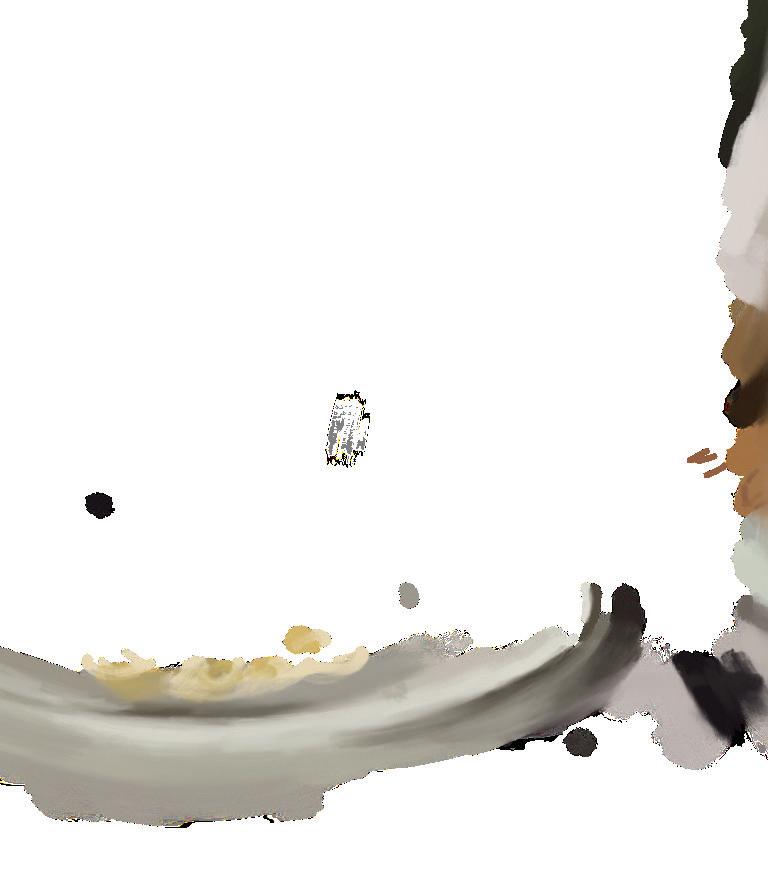
With jagged cobblestone steps leading to the front door, their townhouse was unequivocally Georgetown. Untied shoes haphazardly littered the entryway. Close friends were exchanging playful banter. In place of sophisticated seating sat a lumpy bean bag. We had stepped into an environment that was so college. Relaxed by this comforting and disarming aura, we were quick to assume that their dishes would mimic this laidback energy. Yet, as we met the founders of Dai Tre Fratelli, it was abundantly clear that this pasta bar was more than just a half-hearted side hustle. Though their name translates to “from the three brothers,” Dai Tre Fratelli has four masterminds at work; the name was originally chosen to reference the founders—Cardinali, Dragan Wilms (MSB ’25), and Marcelo Gigliani Alcantarilla (MSB ’25)— before the addition of Jasper Shi (MSB ’24). Head
chefs Cardinali and Wilms lead the kitchen, with the former having grown up in Milan and the latter having roots in Monaco, Germany, and Singapore. The other two, Alcantarilla and Shi, shore up the backend, handling the finances to keep things running smoothly. Despite not growing up with any direct Italian influences, the two also come from extensive international backgrounds (Madrid and Vancouver/Beijing respectively) and share the head chefs’ appreciation for a good bowl of pasta. All four members started Dai Tre Fratelli hoping to bring some sense of home—and some better quality food—to Georgetown’s campus.
It started out with a text from Wilms to Cardinali. “Okay, you know how Georgetown students don’t really have a good alternative for Italian food to Leo’s? And how Leo’s is a bit, um, not the best?”
design by grace nuri 14
LEISURE
Beginning as two friends poking fun at the campus dining hall became a full-fledged business idea. “What we want to bring are these homey dishes and for them to be cost effective to students,” Cardinali explained. With each dish averaging out to about $12, Dai Tre Fratelli’s dishes prove to be much cheaper than local Georgetown restaurants; the average pasta dish at Il Canale costs $22.
Before the door could even fully shut behind us, the guys led us to their dining room, adorned with wrapped silverware, Italian sodas, and most importantly: plates on plates of pasta.
Placed in the very center of the table was their signature cacio e pepe. This dish is not your typical cream-coated Olive Garden Alfredo or Kraft Mac & Cheese. The spaghetti is cooked al dente, then topped with a generous amount of black pepper and freshly shaved pecorino romano, a classic Italian sheep milk cheese. A splash of pasta water is added in and tossed with the pasta, incorporating the starch needed to help the cheese emulsify, culminating in a fragrant creamy sauce. The flavor profile is delectably rich without being overwhelming; the pepper’s crackle on the tongue brings a welcome contrast to the salty cheese base.
The decadent dish is wholly comforting but not one bit too heavy. Originating from Rome, cacio e pepe literally means “cheese and pepper.” The dish is simple, but as Wilms explained, the key to its taste is the quality of the ingredients, a point of pride for the guys at Dai Tre Fratelli.
“We spend a lot on ingredients. A lot of it is imported and we make sure everything’s sourced really well, because we believe that that is what brings out the good taste,” Wilms said. “A lot of restaurants in the area, I think, cheap out on the stuff they put in their pasta. For us who grew up eating it, we can really tell. It's the little stuff, like the oil, like the cheese, that can really make the difference.”
In case we weren’t convinced, Wilms ducked into the kitchen and re-emerged with a 10inch cheese wheel—genuine Pecorino Romano imported straight from Florence. We had to take a minute to decipher the label, written entirely in Italian (we don’t know any Italian). Nevertheless, the guys didn’t need a cheese wheel to convince us their dishes were authentically Italian; the food spoke for itself.
the dish wrapped us in a warm hug, luring us into an unforeseen sense of comfort. This remarkable nostalgia is Dai Tre Fratelli’s ultimate goal.
“There are those moments, like, once a semester, twice a semester, where I really miss the food from home that my family makes. Yes, you can go to a restaurant, but sometimes it’s not as good as I remember. Now that I’m in my junior year, taking a little bit less credits, I feel like I have the time to give back to other students … We think we can help people fill this void while they’re here,” Cardinali explained to us.
The final dish we tried was penne alla vodka, the more authentic cousin to the infamous Gigi Hadid quarantine pasta. Fratelli’s version of the dish skimps on the usual load of heavy cream and instead doubles down on the booze to create a surprisingly refreshing effect. Tangy and remarkably bright, the flavors call to imagination a lounge by the sea on a warm day, soaking in the sun with a cool drink in hand.
The chefs explained that the vodka enhances the tomatoes’ natural citric acidity, placing its tart flavor at center stage. Shi mentioned that they tried experimenting with the conventional method by swapping in other liquors, but found limited success. “From a chemical perspective, it brings out the extra taste of the tomatoes. And it really does matter. I've used rum before and, you know, tequila. It's not very good,” Shi remarked.
Although their first rounds of testing championed tradition, the guys are eager to incorporate more creativity into future iterations of their menu—in particular, they are interested in adding ingredients from other cuisines. The table buzzed with excitement as they envisioned zucchini puree, pistachio pesto, creamy miso, and homemade ravioli.
“We want to be ourselves. We're thinking of, like, something more untraditional and spiced. We want to be proud of ourselves and our creativity. Obviously, we have to keep it classic at the beginning, but when we gain a little bit more reputation and trust from our customers, we definitely want to try some things that are a little bit more out there” said Wilms.
good hour. And we sent that email three times? Three times, to really make sure. So, marketing is definitely a work in progress.”
Outreach wasn’t the only hoop the guys had to jump through; there were significant growing pains as the team tried to cook and sell their pasta. An unprecedented snowstorm in D.C. complicated Fratelli’s original idea of an outdoor event where Georgetown students could bond over their love of food while simultaneously getting to know the creative minds behind Dai Tre Fratelli. This snowstorm shrank Fratelli’s team from four to two, with half the team being stuck at home, unable to get to campus.
As the snowstorm raged throughout Georgetown, many students were (understandably) unwilling to wait outside for some pasta they had never heard of, much less tasted. Needless to say, turnout was low and morale was even lower. Yet, despite the gauntlet of challenges thrown at them, Shi explains how the Dai Tre Fratelli team worked through every single one with grace, treating each as an opportunity for learning.
“I'm an entrepreneurship minor, Marcelo and I. We're both taking these classes. So, you know, it's gotten the juices flowing. But through this experience, a lot of the things that we learned, we actually get to use. And that's super cool. All the pivoting, all the different concepts. Nothing you can learn [in] a classroom compares to doing everything yourself and fucking it up a million times until you get it right.”
Although Dai Tre Fratelli has faced their fair share of trials and tribulations—consisting of lengthy conversations around sourcing ingredients, scouring Tombs night invite lists to get their name out, and cooking pasta in the snow—they have not been deterred from pursuing their initial goal: to warm the hearts (and bellies) of Georgetown students.

The guys truly lean into their Italian influence with their paccheri alla norma. Not an Italian dish that most Americans are familiar with, Fratelli’s paccheri alla norma features a flat, tube-like noodle that serves as a sponge to soak up their homemade pomodoro sauce. Paired with a perfectly roasted eggplant, this dish is a flawless blend of spritely flavor and sinking heartiness. The smokiness of the eggplant and the richness of the burrata coat your tongue with bursts of flavor, but the pomodoro sauce’s acidity cuts through its creaminess and keeps it from weighing you down, allowing us to completely demolish this dish with no regrets.
Perhaps the most notable aspect of the paccheri alla norma is its hominess. At first bite,

While all the guys were more than excited to discuss their future business endeavors, they were not ones to shy away from the difficulties they faced, particularly eager to poke fun at their first attempt at community outreach. With no schoolwide directory at their disposal, they turned to the next best thing: Tombs night email lists.
“We got a list of like, 800 or something people for the first email we sent. We looked through every single Tombs night invite we had ever gotten and just copy and pasted everyone. Thank God they didn’t B.C.C. any of us,” said Gigliani Alcantarilla.
The challenges didn’t stop there. Jasper pointed out how sending the email proved to be a struggle in and of itself. “It’s a funny story. We [first] sent it out from our very corporate Gmail and got about 900 replies from the system that it didn't go through. So our phones were blowing up for like a
As Dai Tre Fratelli has developed from a cool idea to a fully-fledged venture, the name has taken on additional meaning as a tribute to friendships deepened by their shared culinary passion. Our dinner with Fratelli was soundtracked by infectious laughter that infiltrated every corner of the dining room, with all the guys urging us to take food home and share it with our friends. Leaving their townhouse, one thing was clear: there is so much heart behind Dai Tre Fratelli. Hosting an in-person pasta bar event every Friday isn’t easy, but the gratification of seeing their impact within the student body is more than enough to make up for it.
“These Thursday nights and Friday days are really heavy, but when you're speaking with people and you see that they enjoy your food and, like, people are speaking about it on campus, it does bring satisfaction. It's a very good feeling.” said Cardinali.
At its core, Dai Tre Fratelli is a labor of love made with Georgetown students in mind. So, as you attempt to decide between Leo’s and Epi’s, stop by the Arrupe Kitchen on Fridays from 12 p.m. for some wholesome home-cooked meals that’ll leave you feeling warm and fuzzy.
15 MARCH 1, 2024
